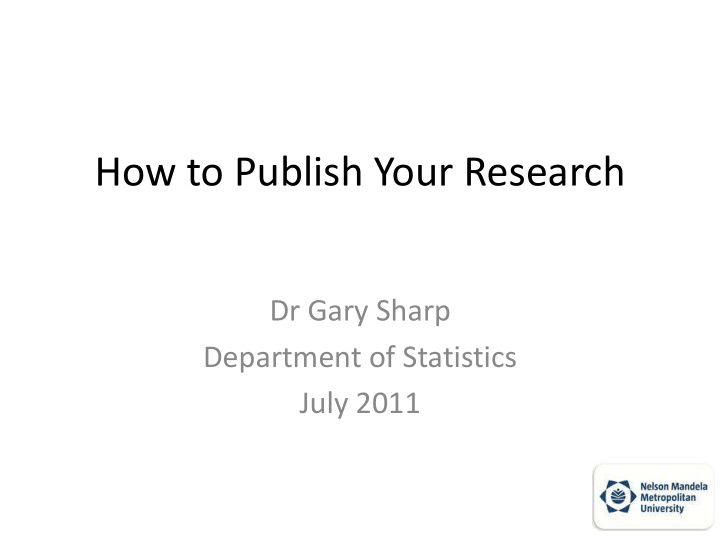



How to Publish Your Research Dr Gary Sharp Department of Statistics July 2011
Introduction • A few pointers before we start the “detail” – Try and publish with an experienced colleague – Always write clearly – Target the right journal – Respond to all reviewer comments – Target accredited journals (only)
Planning manuscript (1) • Read and follow ALL of the guidelines for manuscript preparation listed for an individual journal http://www.rss.org.uk/site/cms/contentCategoryVi ew.asp?category=90 • Use an internal and external peer review service • Critique your own work • Be thorough with several rounds of editing
Planning manuscript (2) • Select a descriptive title • Ideally, your paper should advance a particular line of research • Clear, concise, and grammatically correct English • Write in a precise way, avoid long sentences
Target the right journal (1) • Look at journals that have published articles on your topic previously – In your reference list, check where the reference papers have been published • Example: In writing your paper you are encouraged to review or reference papers in the area you are addressing previously published in the journal. This provides coherence and continuity for our readers. • Look at journal acceptance/rejection rates • Look at average time to publication as well as average time to acceptance/rejection notification
Target the right journal (2) • Look at the publication rate (annual, semi- annual etc) • Look at journal impact factors . • Look at journal fees
Impact Factor • What are they? http://thomsonreuters.com/products_services/scie nce/free/essays/impact_factor/ • How do I find out the impact factor of a particular journal? http://www.sciencegateway.org/rank/index.html http://sciencewatch.com/dr/sci/10/apr25-10_1/ • Why are they “important”? • Should you bother about them?
Submitting a paper • Follow procedure EXACTLY as laid out in the submission to author information • Do not harass the editor in any way • Keep checking the progress of the article (if online progression is available), otherwise be patient
Possible decisions • There is no consistent format for a review response. However there are five “ general ” response – Accept (I believe that this is very seldom the case) – Accept with minor corrections (A very good outcome) – Resubmit after revisions (They are interested, but more work is required) – Reject but may resubmit (Still a chance, but needs a lot of work) – Reject (The final decision in the majority of cases)
Responding to reviewers • Respond to each comment in EXACTLY the format required – If you need to address a structural change, state clearly where the change was done and how it was done. – Highlight the minor editorial changes – Let the editor know that you have addressed all comments. If you choose to challenge a comment, state it clearly and give supporting reasons
What to do if not accepted • This is not the end of the world, one can look at the reviewers comments and then submit elsewhere. • “Everyone” has papers that are rejected, this is all part of the learning cycle. An NRF rated scientist working at NMMU had their first 8 papers rejected. • If after three outright rejections, it would seem that the article is not going to get published, do not waste time, put effort in elsewhere
Reviewing: An example (1) Pythagoras (an SA accredited journal) • Is the paper interesting is it accessible and of interest to the (South African and AMESA) Mathematics Education community? • Is the paper significant does it make an original and substantial contribution to Mathematics Education? • Is the paper appropriately contextualised in the research literature does it take appropriate account of, and build on previous related work? Are the references adequate (and are they all necessary)?
Reviewing: An example (1 cont.) • Is the paper structurally sound is there a sound and well-communicated argument? (For a research paper is there an appropriate match between the research question(s) and the methods and analysis used to answer the question? For a theoretical paper is there an appropriate theoretical framework evident?) • Does the title give a clear indication of the focus of the paper? • Does the abstract summarise the paper adequately? • Or the other way around: does the paper indeed deliver what the abstract promised? • Is the language of the paper sufficiently fluent and clear?
Reviewing: An example (1 cont.) • What is your recommendation with respect to publication? Mark one box below with an X and then in 9 supply detailed reasons for your recommendation . Accept without changes Accept with minor changes , as I indicated Reconsider after major revisions , as I suggested (re-submit, then re-review) Reject the paper is not acceptable to be published in Pythagoras • Reasons for your recommendation above:
Accredited journals • In South Africa there are two accredited lists • International Science Index (ISI) list (Now referred to as the Science Citation Index) • DoE accredited (national) list • http://www.nmmu.ac.za/default.asp?id=5549 &bhcp=1
Examples: Accredited international journals • Journal of the Operational Research Society – http://www.palgrave- journals.com/jors/index.html • Applied Stochastic Models in Business and Industry – http://onlinelibrary.wiley.com/journal/10.1002/(IS SN)1526-4025 • Restrictions: These are not freely available, a subscription is required
Example: Accredited local journals • South African Statistics Journal – Volume 43(2), 2009 • Investment Analysts Journal – Vol 69, 2009 • These are freely available through the library subscription to SABINET
How does one evaluate a researcher? • Number (and quality) of (subsidisable) articles published • Number of citing's received (a measure of quality) • NRF rating of researcher (measure of quantity and quality)
How does one evaluate a researcher? • Number of doctoral and masters graduates supervised • Number of invited addresses and conference papers given • Editorial and scholarly peer reviewing duties • External examining duties
Now for some fun • Erdo’s numbers – What is an Erdo’s number? – What is my Erdo’s number? – Are they really important?
The end • Thanks for your attendance, go out and make us proud!!!
Recommend
More recommend